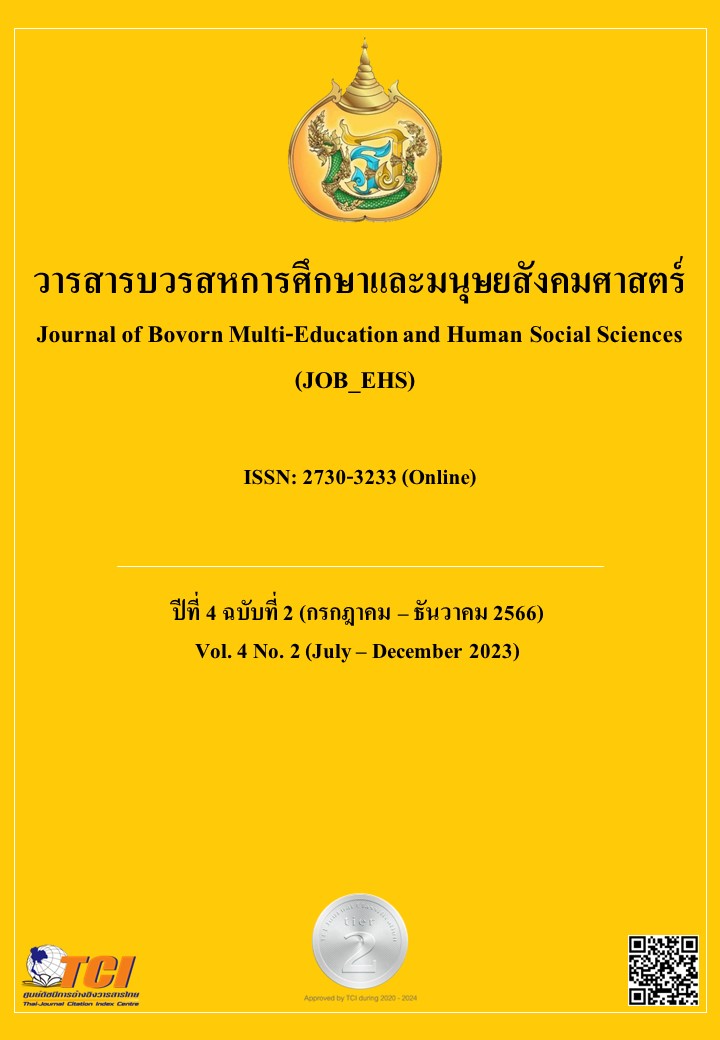การจัดการเรียนรู้เชิงรุก: การสร้างแรงบันดาลใจและเพิ่มพูนทักษะของผู้เรียนในกระบวนการเรียนการสอน
Main Article Content
บทคัดย่อ
การเรียนรู้เชิงรุก (Active Learning, AL) เป็นเครื่องมือที่สำคัญในการปรับปรุงระบบการศึกษาให้เข้ากับการเปลี่ยนแปลงของสังคมและกระบวนการเรียนรู้ที่เปลี่ยนแปลงอย่างรวดเร็วในปัจจุบัน ไม่เพียงแค่เพิ่มคุณค่าให้กับกระบวนการเรียนรู้ แต่ยังช่วยส่งเสริมพลังทักษะทางทัศนคติ การแก้ไขปัญหา และความสามารถในการทำงานร่วมกับผู้อื่น ผ่านการใช้เครื่องมือต่างๆ เช่น การประเมินตนเอง แผนผังแนวคิด และการประเมินโดยเพื่อนร่วมเรียน ทั้งนี้เพื่อให้ผู้เรียนได้รับการเรียนรู้ที่มีคุณภาพและสอดคล้องกับความต้องการของสังคมที่เปลี่ยนแปลงอย่างรวดเร็ว อย่างไรก็ตาม ยังพบว่ามีอุปสรรคและความท้าทายในกระบวนการ AL ซึ่งผู้สอนสามารถจัดการข้อจำกัดเหล่านี้ได้อย่างมีประสิทธิภาพ โดยการวางแผนและออกแบบกิจกรรม การจัดการเวลา การเรียนรู้ของผู้เรียน การปรับตัวของผู้สอน รวมถึงการเตรียมการและทรัพยากรเพื่อให้การนำเสนอ AL เข้ากับความต้องการและสภาพแวดล้อมการเรียนรู้ในสมัยที่เปลี่ยนแปลงอย่างรวดเร็ว จึงสรุปได้ว่าแนวคิดของ AL เป็นสิ่งสำคัญและมีผลสำคัญในการสร้างประสบการณ์การเรียนรู้ที่มีคุณค่าและช่วยพัฒนาทักษะของผู้เรียนให้เติบโตและพัฒนาอย่างเต็มศักยภาพ ด้วยแนวคิดและเครื่องมือที่เสนอในบทความนี้ เราสามารถสร้างประสบการณ์การเรียนรู้ที่มีคุณค่าและส่งผลให้ผู้เรียนเติบโตและพัฒนาทักษะที่จำเป็นในสังคมของอนาคตได้อย่างมีประสิทธิภาพและความสุข
Article Details

อนุญาตภายใต้เงื่อนไข Creative Commons Attribution-NonCommercial-NoDerivatives 4.0 International License.
บทความที่ส่งมาขอรับการตีพิมพ์ในวารสารบวรสหการศึกษาและมนุษยสังคมศาสตร์ จะต้องไม่เคยตีพิมพ์หรืออยู่ระหว่างการพิจารณาจากผู้ทรงคุณวุฒิเพื่อตีพิมพ์ในวารสารอื่น รวมทั้งผู้เขียนจะต้องคำนึงถึงจริยธรรมการวิจัย ไม่ละเมิดหรือคัดลอกผลงานของผู้อื่นมาเป็นของตนเอง ซึ่งทางวารสารฯ ได้กำหนดความซ้ำของผลงาน ด้วยโปรแกรม CopyCat เว็บ Thaijo ในระดับ ไม่เกิน 25%
ในกรณีที่ บทความวิจัยมีกระบวนการวิจัยเกี่ยวข้องกับมนุษย์ ผู้นิพนธ์จะต้องส่งหลักฐานการรับรองจริยธรรมการวิจัยในมนุษย์มาประกอบการลงตีพิมพ์ด้วยจึงจะได้รับการพิจารณาลงตีพิมพ์ในวารสาร
ผู้เขียนบทความจะต้องปฏิบัติตามหลักเกณฑ์การเสนอบทความเพื่อตีพิมพ์ในวารสารบวรสหการศึกษาและมนุษยสังคมศาสตร์ รวมทั้งระบบการอ้างอิงต้องเป็นไปตามหลักเกณฑ์ของวารสารบวรสหการศึกษาและมนุษยสังคมศาสตร์ โดยรวมทั้งทัศนะและความคิดเห็นที่ปรากฏในบทความในวารสารบวรสหการศึกษาและมนุษยสังคมศาสตร์ ถือเป็นความรับผิดชอบของผู้เขียนบทความนั้น และไม่ถือเป็นทัศนะและความรับผิดชอบของกองบรรณาธิการวารสารบวรสหการศึกษาและมนุษยสังคมศาสตร์และวารสารบวรสหการศึกษาและมนุษยสังคมศาสตร์
เอกสารอ้างอิง
พิมพันธ์ เดชะคุปต์. (2560). เปิดประเด็น: เหลียวหลังแลหน้าการศึกษาไทย 4.0. Journal of Education Studies. 45(2). 304-309.
วิลาวัณย์ หาระมี และไชยยศ เรืองสุวรรณ. (2533). ผลการใช้โปรแกรมบทเรียนและการสอนปกติต่อผลสัมฤทธิ์ทางการเรียนและเจตคติต่อการเรียนภาษาอังกฤษ ความคงทนในการเรียนรู้ภาษาอังกฤษเรื่องคำศัพท์นักเรียนชั้นประถมศึกษาปีที่ 2. วารสารวิชาการมหาวิทยาลัยราชภัฏบุรีรัมย์มนุษยศาสตร์และสังคมศาสตร์. 2(2). 56-66.
สุคนธ์ สินธพานนท์. (2560). ครูยุคใหม่กับการจัดการเรียนรู้ สู่การศึกษา 4.0. กรุงเทพมหานคร: ศูนย์หนังสือจุฬาลงกรณ์มหาวิทยาลัย.
Barkley, E. F., Cross, K. P. and Major, C. H. (2014). Collaborative learning techniques: A handbook for college faculty. John Wiley & Sons.
Barrows, H. S. (1986). A taxonomy of problem‐based learning methods. Medical education. 20(6). 481-486.
Bates, L., Watson, B. and King, M. (2008). The structure of the learner licence affects the type of experiences novices gain during this phase-Examples from Queensland and New South Wales. Journal of the Australasian College of Road Safety. 19(4). 36-42.
Bonwell, C. C. and Eison, J. A. (1991). Active learning: Creating excitement in the classroom. 1991 ASHE-ERIC higher education reports: ERIC.
Buitrago-Flórez, F., Danies, G., Restrepo, S. and Hernández, C. (2021). Fostering 21st Century Competences through Computational Thinking and Active Learning: A Mixed Method Study. International Journal of Instruction. 14(3). 737-754.
Cardullo, V. M., Wilson, N. S. and Zygouris-Coe, V. I. (2018). Enhanced student engagement through active learning and emerging technologies. Student engagement and participation: Concepts, methodologies, tools, and applications. IGI Global.
Chan, K., Cheung, G., Brown, I. and Luk, G. (2015). Synthesizing technology adoption and learners' approaches towards active learning in higher education. Paper presented at the international conference on e-learning.
Eison, J. (2010). Using active learning instructional strategies to create excitement and enhance learning. Jurnal Pendidikantentang Strategi Pembelajaran Aktif (Active Learning) Books. 2(1). 1-10.
Erdmann, A., Wrisley, D. J., Brown, C., Cohen-Bodénès, S., Elsner, M., Feng, Y., de Marneffe, M.-C. (2019). Practical, efficient, and customizable active learning for named entity recognition in the digital humanities. In Long and Short Papers. (NAACL HLT 2019 - 2019 Conference of the North American Chapter of the Association for Computational Linguistics: Human Language Technologies - Proceedings of the Conference; Vol. 1. Association for Computational Linguistics (ACL).
Felder, R. M. and Brent, R. (1996). Navigating the bumpy road to student-centered instruction. College teaching. 44(2). 43-47.
Felder, R. M. and Brent, R. (2009). Effective teaching: A workshop. Chemical Engineering Education. 43(1). 15-16.
Freeman, S., Eddy, S. L., McDonough, M., Smith, M. K., Okoroafor, N., Jordt, H. and Wenderoth, M. P. (2014). Active learning increases student performance in science, engineering, and mathematics. Proceedings of the national academy of sciences. 111(23). 8410-8415.
Fritz, K., Schoenmueller, V. and Bruhn, M. (2017). Authenticity in branding–exploring antecedents and consequences of brand authenticity. European journal of marketing. 51(2). 324-348.
García-Holgado, A., García-Peñalvo, F. J. and Rodríguez-Conde, M. J. (2018). Pilot experience applying an active learning methodology in a Software Engineering classroom. Paper presented at the 2018 IEEE Global Engineering Education Conference (EDUCON).
Harmin, M. and Toth, M. (2006). Inspiring active learning: A complete handbook for today's teachers. ASCD.
Hattie, J. and Timperley, H. (2007). The power of feedback. Review of educational research. 77(1). 81-112.
Hmelo-Silver, C. E., Duncan, R. G. and Chinn, C. A. (2007). Scaffolding and achievement in problem-based and inquiry learning: a response to Kirschner, Sweller, and. Educational psychologist. 42(2). 99-107.
Hodges, L. C. (2020). Student engagement in active learning classes. Active learning in college science: The case for evidence-based practice.
Johnson, D. W., Johnson, R. T. and Smith, K. A. (2014). Cooperative learning: Improving university instruction by basing practice on validated theory. Journal on Excellence in University Teaching. 25(4). 1-26.
Johnson, L., Becker, S. A., Cummins, M., Estrada, V., Freeman, A. and Hall, C. (2016). NMC horizon report. 2016 higher education edition: The New Media Consortium.
Machemer, P. L. and Crawford, P. (2007). Student perceptions of active learning in a large cross-disciplinary classroom. Active learning in higher education. 8(1). 9-30.
Meyers, C. and Jones, T. B. (1993). Promoting Active Learning. Strategies for the College Classroom: ERIC.
Michaelsen, L. K., Knight, A. B. and Fink, L. D. (2002). Team-based learning: A transformative use of small groups. Greenwood publishing group.
Misseyanni, A., Lytras, M. D., Papadopoulou, P. and Marouli, C. (2018). Active learning strategies in higher education. Teaching for leadership, innovation, and creativity: Emerald Publishing Limited.
Munna, A. S. and Kalam, M. A. (2021). Impact of Active Learning Strategy on the Student Engagement. GNOSI: an interdisciplinary journal of human theory and praxis. 4(2). 96-114.
Nilson, L. B. (2016). Teaching at its best: A research-based resource for college instructors. John Wiley & Sons.
Novak, J. D. and Cañas, A. J. (2006). The theory underlying concept maps and how to construct them. Florida Institute for Human and Machine Cognition. 1(1). 1-31.
Prince, M. (2004). Does active learning work? A review of the research. Journal of engineering education. 93(3). 223-231.
Schmidt, H. G. (1993). Foundations of problem‐based learning: some explanatory notes. Medical education. 27(5). 422-432.
Sedden, M. L. and Clark, K. R. (2016). Motivating students in the 21st century. Radiologic Technology. 87(6). 609-616.
Stevens, D. D. and Levi, A. J. (2023). Introduction to rubrics. An assessment tool to save grading time, convey effective feedback, and promote student learning: Routledge.
Topping, K. J. (2009). Peer assessment. Theory into practice. 48(1). 20-27.
Tucker, B. (2012). The flipped classroom. Education next. 12(1). 82-83.

